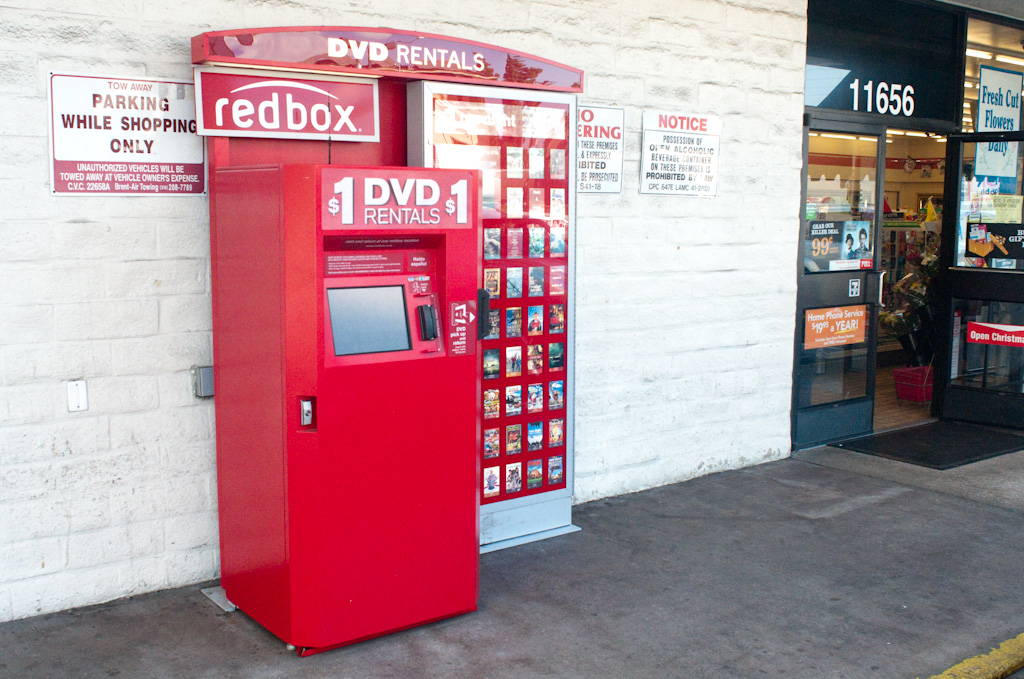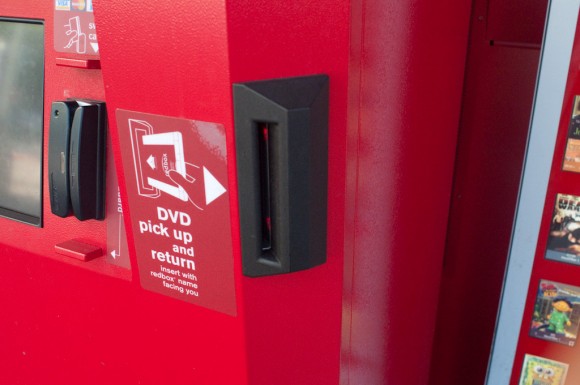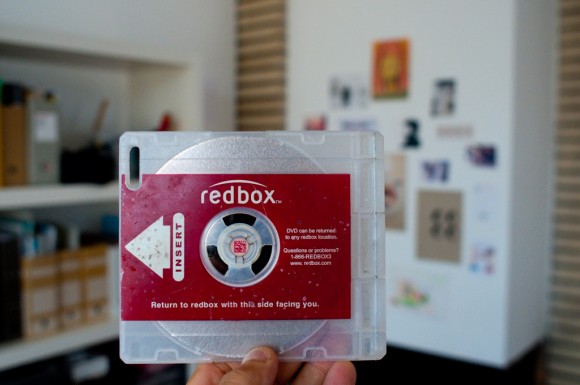The little neighbourhood of Los Angeles that I currently call home includes a 7/11 store that ebbs and flows to the rhythm of the local community: early morning commuters picking up their drive-to-work breakfast; the late-afternoon latino highschool kids alternating between preening and munching Doritos; a late night beacon for some of the many, many homeless who live around these parts. The 7/11 also includes an increasingly familiar site in the US of A: a redbox video vending machine. It looks innocent enough and sure I’ve walked past it enough times with nary a glance, but its modest frame belies its impact on our future perfect.
If you shut your eyes and listen carefully you can hear the sound of a machete cleaving its way through the neck of a dying, bloated cash-cow by the name of Blockbuster. That roar? That’s you and you and you and me standing by the sidelines cheering in relief at knowing we’re never going to put up with that kind of experience again. redbox’s parent company, Coinstar who modestly pitch themselves as ‘the world’s leading supplier of valuable services that make life easier for consumers’ has reinvented the rental of tangible media through destination site big-box video stores and consumers are lovin’ it. And that sharp intake of breath? That’s the major studios compelled to watch the slaughter from the side lines but who are now wondering how they are going to pay for their dry cleaning bill from blood splatters.
American customers can browse titles in any given vending machine and make a reservation online – try it here (non-US readers might want to start with the zipcode 90210). Since one vending machine holds up to 500 DVD units you’re not going to find Delicatessen or Vanishing Point but that misses the point – it’s like complaining that the Flip is too simple to use. All of their movies including new releases are offered at flat cost of $1 + tax for one nights rental. Interaction is minimal – the vending machine has a touch screen, one slot for receiving/returning DVDs and a credit card swiper. Without the need to hire in-store staff, their HR needs are focussed on customer support; keeping vending machines stocked with the latest releases and updating the advertising poster. The niggly issue of cleaning the DVDs is passed onto the customer – and I suspect scratched media is one of their biggest headaches.
Whilst their vending machines have prime placement next to the entrance of many 7/11+ stores – the cost of renting this space is likely to be discounted because DVD rental encourages footfall – a video watched one day is likely to be returned the next. By being able to browse titles online the time-consuming guesswork is taken out of the rental process and with ~19,000 machines in the US and growing they are becoming ubiquitous. Whilst humans are creatures of habit and are likely to return the DVD to the same machine it was rented from the model also supports the convenience-psychology of ‘DVDs can be returned to any redbox’. Props to redbox for making movie rental process as convenient as nipping down to the corner store to buy popcorn to snack on whilst you’re watching the movie. By, golly the coders amongst you are enjoying the infinite loopness of it all. They’ve delivered up against nimble competitors such as NetFlix and the Brother’s Torrent.
For those of you glancing nervously into the future perfect redbox’s real impact goes far further than merely renting out DVDs: they have introduced new forms of interaction into the American urban landscape making it more acceptable to use touch screens to browse content in high-footfall, outdoor public spaces; it introduces non-beverage/non-snack vending machine use to a new demographic; and most importantly the value proposition provides sufficient pull for customers to take out a credit card and swipe to authenticate (for rental pick-ups) and complete transactions. Yes – this swiping behaviour is the mainstay of petrol/gas stations on this side of the pond, but the physical distance between customers and passers by is that much less with a redbox, the process is that much more observable. Lovely stuff. In years to come, the more reflective amongst you will recognised this as an important evolutionary leap for American consumers, so often global ‘technology’ laggards.
Some trends to consider before we leap into 2010: as our abilty to track objects, people and their preferences is continually refined – how small can the marketplace/vending machine for tangible media and other goods go? Why doesn’t every apartment block have it’s own redbox equivilent?; what value added services might be introduced to add convenience – the obvious being neighbourhood delivery and pick-up, and given that this hasn’t yet evolved in the US of A in which cultures is it more likely occur? For people and communities with limited access to high-speed connectivity this could be the platform to extend the internet.
And at what point can a similar infrastructure support the just-in-time creation of other tangible objects? The obvious is to burn content onto a DVD/SD/… for pickup, but with 3D printers new, valued forms will emerge. Don’t think of it as a vending machine but a platform through which to support the time-shifted exchange of tangible objects.
What does a company with prime, interactive, transactional real estate do next? A space to watch.
Wall Street Journal has a litle write up of RedBox versus Blockbuster Express here and more on micro-markets here.
Way, way too long to be writing on a day like today – mountains + pain beckon.


